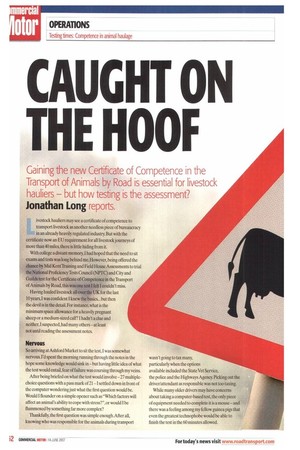CAUGHT ON THE HOOF
Page 62

Page 63

If you've noticed an error in this article please click here to report it so we can fix it.
Gaining the new Certificate of Competence in the Transport of Animals by Road is essential for livestock
hauliers but how testing is the assessment?
Jonathan Long reports.
ivestock hauliers may see a certificate of competence to transport livestock as another needless piece of bureaucracy in an already heavily regulated industry. But with the certificate now an EU requirement for all livestock journeys of more than 40 miles, there is little hiding from it.
With college a distant memory,I had hoped that the need to sit exams and tests was long behind me. However, being offered the chance by Mid KentTraining and Field House Assessments to trial he National Proficiency Tests Council (NPTC) and City and Guilds test for the Certificate of Competence in the Transport of Animals by Road, this was one test I felt !couldn't miss.
Having hauled livestock all over the UK for the last 10 years,1 was confident I knew the basics... but then the devil is in the detail. For instance, what is the minimum space allowance for a heavily pregnant sheep or a medium-sized calf? I hadn't a clue and neither, I suspected, had many others at least not until reading the assessment notes.
Nervous
So arriving at Ashford Market to sit the test,! was somewhat nervous. I'd spent the morning running through the notes in the hope some knowledge would sink in — but having little idea of what the test would entail, fear of failure was coursing through my veins.
After being briefed on what the test would involve —27 multiplechoice questions with a pass mark of 21 — I settled down in front of the computer wondering just what the first question would be. Would! flounder on a simple opener such as "Which factors will affect an animal's ability to cope with stress?".or would Ibe flummoxed by something far more complex?
Thankfully, the first question was simple enough. After all, knowing who was responsible for the animals during transport wasn't going to tax many, particularly when the options available included the State Vet Service, the police and the Highways Agency. Picking out the driver/attendant as responsible was not too taxing.
While many older drivers may have concerns about taking a computer-based test, the only piece of equipment needed to complete it is a mouse — and there was a feeling among my fellow guinea pigs that even the greatest technophobe would be able to finish the test in the 60 minutes allowed. Answering the 27 questions was, on the sheep and cattle test, a relatively straightforward task, holding no fear for anyone with a modicum of common sense. Some of the questions required a little thought but, once two or three were under my belt,the format was familiar. And with two of the four possible answers for each question always reasonably ridiculous, I could apply the Who Wants To Be A Millionaire 50:50 strategy and have a fair chance of picking the right answer from the two remaining.
20 minutes later...
So only 20 minutes into the test, I found myself tackling question 27 out of 27 and wondering, as I was finishing well ahead of time whether I'd missed a couple in the middle.
A quick review of my work revealed that! had, indeed, answered all the questions and I was fairly confident that I had given each of them my best shot.
A short time later, and my fate was revealed. I, along with everyone else sitting the test that day, including instructors Chris Smith and Alan West,had passed and more than that, I'd managed a full house of correct answers, something I can't remember achieving since sitting a spelling test at the age of nine.
Overall, then, this is one test I am more than happy to recommend.The qualification provides a high level of reassurance to the rest of the food chain that those of us involved in livestock transportation are operating with animal health and welfare where it should beat the top of the agenda..


























































































































































































